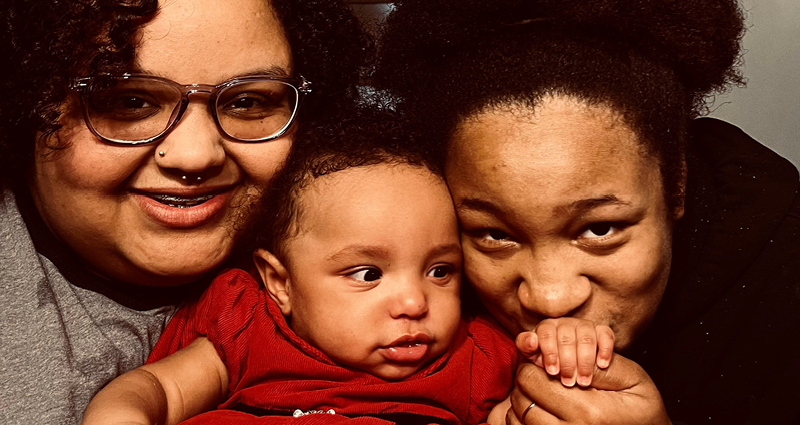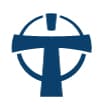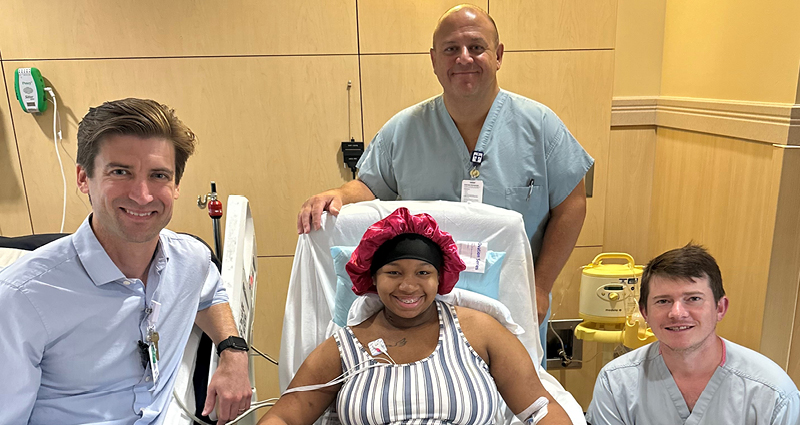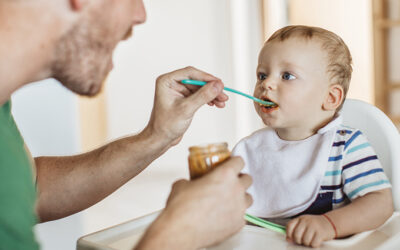Sometimes, how we healthcare is the strength of many hospitals acting as one ministry of healing.
On a recent afternoon, sisters Ashia Abraham and Kayla Labbe giggle as they feed Ashia’s 10-month-old daughter in her highchair. The baby is enjoying macaroni and cheese, although just as much of it ends up on her face as in her mouth.
It’s a moment of normalcy that seemed far out of reach last summer after Abraham suffered severe and unexpected complications that led to her fighting for her life and receiving state-of-the-art treatment at Our Lady of the Lake Regional Medical Center in Baton Rouge.
A Scary Turn Late in Pregnancy
Abraham’s pregnancy was progressing normally until she reached the 30-week mark, when she awoke one morning with unexplained swelling. When it didn’t subside after several hours, Labbe brought her to the nearest hospital – Our Lady of Lourdes Women’s & Children’s Hospital in Lafayette. Numerous tests revealed that Abraham had gestational diabetes, pre-eclampsia and high blood pressure. Her condition deteriorated rapidly, and Abraham was soon experiencing severe pain and difficulty breathing.
Doctors at Our Lady of Lourdes Women’s & Children’s induced labor, and the baby girl was healthy but small because she was born prematurely. It was a different story for Abraham. By that point, her lungs had filled with fluid and she was not responding well to breathing treatments and ventilation.
After several attempts to stabilize her condition, doctors suggested Abraham may be a candidate for the extracorporeal membrane oxygenation (ECMO) program at Our Lady of the Lake.
What is ECMO and When Is It Used?
“ECMO is for patients who have a failing heart, failing lungs or both,” said Dr. Owen Stell, ECMO Medical Director at Our Lady of the Lake. “The machines do not heal the patient but allow their body time to rest while other therapies help them to get better. This is an option when other treatments have failed and the patient continues to worsen and is not getting enough oxygen or blood flow.”
The ECMO program started at Our Lady of the Lake last summer, becoming the first program of its kind in the Baton Rouge region. The program can accommodate up to three patients at a time, said Ryan Landry, DNP, vice president, Clinical Operations for Cardiovascular, Rehabilitative/Physical Medicine and Clinical Research Service Lines.
“The complexity of our cardiovascular programs has progressed over time,” Landry noted. “We kept getting a number of patients that we felt could benefit from advanced life support at the bedside. It took a lot of time to make sure we had the equipment and training in place, but once Dr. Stell joined us, we knew we were on the right track. You always need a physician to own an ECMO program and coordinate all of the care. Once we had that, as well as a core group of clinicians and an elite nursing unit, we knew we were ready to offer our program to patients.”
A Sister’s Hope and a Turning Point
Abraham was initially connected to ECMO devices at Our Lady of Lourdes Regional Medical Center in Lafayette, then transported via ambulance to Our Lady of the Lake Regional Medical Center. Labbe said she was somewhat skeptical of ECMO at first, since she had only heard of it briefly on social media, and only when it was unsuccessful. Yet, seeing her sister in distress with limited options prompted Labbe to agree to the treatment.
“It had been at least a week when they called to tell me they were turning the ECMO off,” Labbe recalled. “At that point, I felt I could start to be more hopeful. I knew that if she knew she had her baby, she was going to fight. That call felt like a turning point.”
Landry said those kinds of improvements are due both to the advanced technology used in ECMO as well as the oversight from highly trained personnel, including Dr. Stell, an interventionist, a registered nurse and an ECMO specialist, as well as input from respiratory therapists, heart surgeons, social workers and case managers.
“The ECMO unit is located where we have some of the sickest patients in the hospital, and this team is used to working collaboratively and having honest discussions about the treatment,” Landry said. “We also go out of our way to make sure we form a relationship with the patient and his or her family upfront. It’s important to us to maintain a connection with people who love this person.”

Back to Family, Back to Life
Like many patients who receive ECMO, Abraham has no memory of the ordeal. When she awoke, she was surprised to learn that almost two weeks had passed, instead of a single day.
“I had no sense of time,” she said. “My jaw almost dropped on the floor when I found out how long it had been. It really scared me. I was really happy I was still alive, but it was a bittersweet moment because I realized I had missed almost a whole month with my baby. But, it was worth it in the end, and I am eternally grateful.”
Abraham has come a long way since her ECMO treatment. She gave birth to her second child, a son, in March. Her recovery is going well, although she does still struggle with memory issues. Labbe remains there for all of them, filled with gratitude and still emotional when she thinks about how differently things could have turned out.
“My sister has always been my best friend, even though I’m 10 years older than her,” Labbe said. “Our mom passed away three years ago, and our bond has only gotten stronger since then. I can’t imagine doing my life without her.”
Saving More Lives, One Breath at a Time
Although the ECMO program at Our Lady of the Lake is still relatively new, it is showing strong results. Landry said 13 patients have been treated within the past year, and the program’s mortality rates are significantly lower than the national average. Some patients are transferred to the program after being admitted to Our Lady of the Lake for other treatment, while others, like Abraham, are brought there from other hospitals.
“Our Lady of the Lake is well-positioned to provide elite services in the cardiovascular space,” Landry said. “We have the talent, skills and services here to continue to develop this program and other types of advanced services. We all have big ideas about how we want to continue helping people. We’ve made so much progress over the past year, and I’m excited to see what we can do in the future.”




